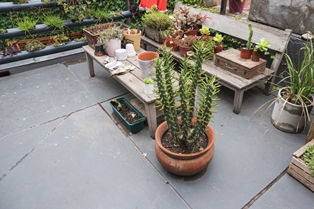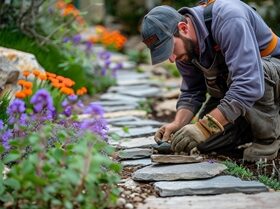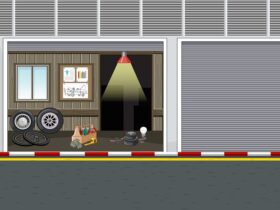Garden edging plays a crucial role in defining garden spaces, creating clear boundaries, and enhancing the aesthetic appeal of your outdoor areas. The right edging not only adds visual interest but also helps manage plant growth and prevents soil erosion. However, garden edging can be costly if you’re not careful. Here, we’ll explore a variety of inexpensive garden edging ideas that will help you achieve a polished look without breaking the bank.
1. Stone Edging

Stone edging is a timeless choice that adds a natural, rustic touch to your garden. The great thing about stone is that you can find it almost anywhere, especially if you live in a rural area or near a quarry. Collecting stones from local sources is an environmentally friendly and budget-conscious approach. You can use larger stones for a dramatic effect or smaller stones for more subtle edging. Consider creating patterns or stacking stones for added texture. This method is durable and weather-resistant, making it a cost-effective long-term solution.
2. Brick Edging

Brick edging offers a classic, structured look that complements various garden styles. If you have leftover bricks from a construction project or know of a place that sells recycled bricks, this can be a very affordable option. Bricks can be laid flat for a low-profile edge or set on their sides for a raised border. This flexibility allows you to create custom designs that suit your garden’s shape and theme. Additionally, bricks are sturdy and can withstand heavy foot traffic, ensuring your garden edging lasts for years.
3. Wooden Edging

Wooden edging is a versatile option that can be used to create a wide range of looks, from rustic to contemporary. You can repurpose old wooden planks, railway sleepers, or even wooden logs for a natural and budget-friendly garden edge. Wood is easy to work with and can be cut into different shapes and sizes to fit your garden’s layout. However, keep in mind that wood may require treatment or sealing to prevent rot, especially if it’s in direct contact with soil and moisture. Despite this, wooden edging remains a cost-effective and charming option.
4. Metal Edging

Metal edging provides a sleek and modern appearance, perfect for contemporary garden designs. It can be made from recycled materials, making it both eco-friendly and budget-conscious. Thin strips of metal can be bent and shaped to create curves or straight lines, offering a high level of customization. While metal edging is typically more expensive than stone or wood, you can find affordable options by looking for recycled metal or checking local scrap yards. Metal edging is also highly durable and resistant to weather conditions, ensuring it will last a long time.
5. Concrete Edging
Concrete edging is an excellent choice if you’re looking for a durable and low-maintenance option. You can create concrete edging using molds, which allows you to customize the shape and design. This method is ideal for creating smooth curves or intricate patterns. Concrete is also a fantastic material for those who want to incorporate colored pigments or decorative elements into their garden edging. While it may require a bit more effort to set up and pour, concrete edging can be an affordable long-term solution with minimal maintenance needs.
6. Recycled Materials Edging
Recycled materials can be a goldmine for inexpensive garden edging. Consider using old bottles, tiles, or even broken pottery to create unique and artistic garden borders. This approach not only reduces waste but also adds a creative and personal touch to your garden. Bottles can be buried neck-down to create a glass border, while broken tiles can be arranged in mosaic patterns for a colorful and eye-catching edge. Recycled materials offer endless possibilities for customization, allowing you to express your creativity while keeping costs low.
7. Natural Plant Edging
Using plants as garden edging is a wonderful way to integrate nature into your garden design. Low-growing plants like lavender, thyme, or boxwood can create a living border that adds color and texture. This approach is not only cost-effective but also beneficial for attracting pollinators and supporting local ecosystems. Plant-based edging requires some maintenance to keep plants trimmed and tidy, but it offers a soft and organic look that complements any garden style.
8. Gravel Edging

Gravel edging is a simple and budget-friendly option that provides a clean and tidy look. You can use gravel to create clear pathways or borders around garden beds. Gravel comes in various sizes and colors, allowing you to customize the look to suit your garden’s aesthetics. It’s also easy to install and requires minimal maintenance, making it an ideal choice for busy gardeners. Additionally, gravel helps with drainage, reducing the risk of soil erosion and water buildup around your garden beds.
FAQs
Here are the FAQ answers:
Garden edging offers several benefits. It creates clear boundaries between different areas, such as garden beds and pathways, enhancing your garden’s overall appearance. Edging also helps contain plants, preventing them from spreading into unwanted areas. Additionally, it reduces soil erosion and provides a barrier against lawn encroachment. By clearly defining spaces, edging makes garden maintenance more manageable and organized.
Many materials are suitable for inexpensive garden edging. Popular options include stone, brick, wood, metal, concrete, and recycled materials. Stone and brick are durable and offer a classic look, while wood provides a rustic touch. Metal and concrete are ideal for modern aesthetics and durability. Recycled materials like old bottles, broken tiles, or pottery can add a unique, artistic flair without a high price tag. The best material for you depends on your garden’s style, budget, and desired level of maintenance.
Maintaining garden edging on a budget involves a few key practices. First, choose durable materials like stone, brick, or concrete, which require less frequent replacement. For wooden edging, use treated wood to prevent rot and ensure it is properly sealed. Regularly check for signs of wear or damage, and make small repairs to prevent larger issues. Keep plant-based edging trimmed and tidy, and remove weeds that might grow along the edges. Consistent maintenance helps keep costs down by avoiding major repairs or replacements.
DIY garden edging projects are generally manageable with basic tools and materials. The difficulty level depends on the chosen material and the complexity of the design. Stone and brick edging typically require basic stacking or laying, while wood may need cutting and treatment. Concrete projects involve creating molds and pouring concrete, which might require more effort but are still achievable for most DIY enthusiasts. Consider starting with simpler designs if you’re new to DIY projects, and follow online tutorials for guidance.
Combining different edging materials in your garden is a creative and practical approach. You can mix and match materials to achieve unique designs and add visual interest. For example, you might use stone edging around pathways and brick edging around garden beds. Combining materials allows you to leverage each material’s strengths while creating a cohesive look. Ensure the transition between different materials is smooth and aesthetically pleasing to maintain harmony throughout your garden design.
Conclusion
With these inexpensive garden edging ideas, you can transform your garden into a well-defined and visually appealing space without overspending. Whether you prefer the natural beauty of stone, the classic charm of brick, or the creative possibilities of recycled materials, there’s an edging solution to suit every taste and budget. Experiment with different materials and designs to find the perfect fit for your garden.











Find Us on Socials